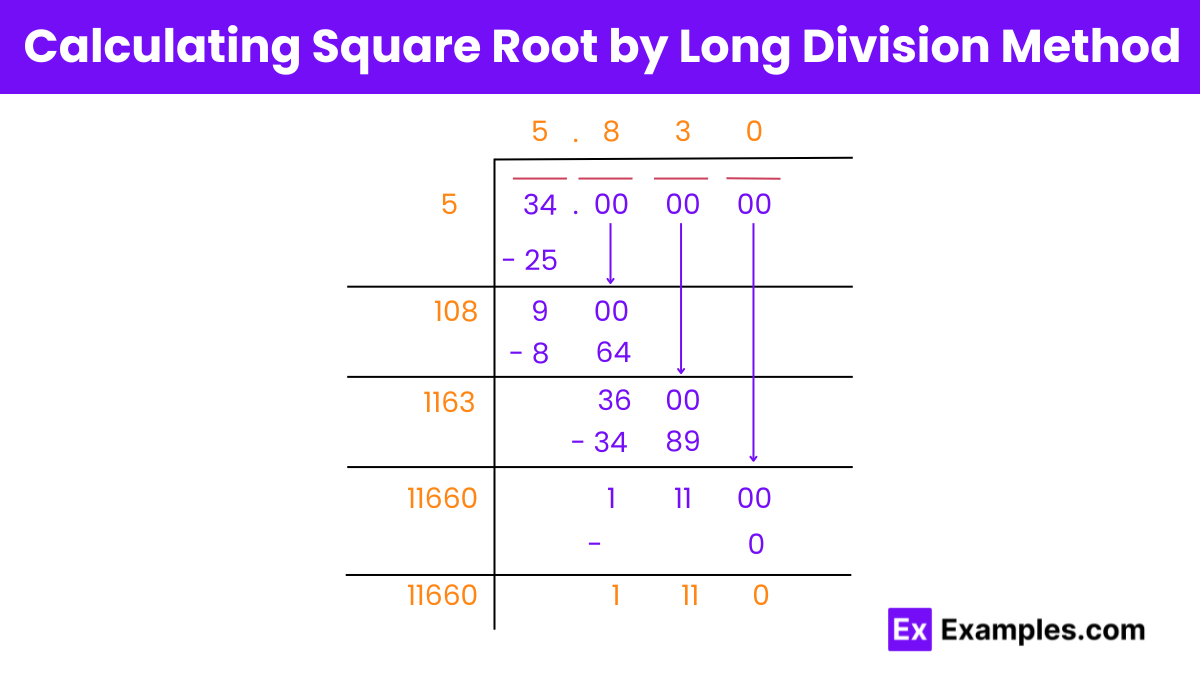What is the approximate square of 34?
1156
1024
1089
1296

The square number of 34 is equal to 1156. This is found by multiplying 34 by itself, resulting in the square value. In mathematical terms, it can be represented as 34² = 1156.
√34 = 5.83095189485
Or
√34 =5.830 up to three places of decimal
The square root of 34 is approximately 5.83. It is an irrational number, meaning it cannot be expressed as a simple fraction. It lies between 5 and 6 on the number line.
Expressed symbolically, the square root of 34 can be represented as √34.
Approximately, the square root of 34 is equal to about 5.83095189485.
Square Root of 34: 5.83095189485
Exponential Form: 34^½
Radical Form: √34
This means it cannot be expressed as a fraction of two integers and its decimal representation goes on infinitely without repeating.
It is a non-repeating, non-terminating decimal.
To understand why, let’s delve into the definitions of rational and irrational numbers.
Rational numbers are those that can be expressed as a fraction where the numerator and denominator are both integers, with the denominator not being zero. They include numbers like 1/2, 3/4, -5/2, and so on.
Examples: 1/2, 3/4, −5/2 etc.
Irrational numbers are real numbers that cannot be expressed as a fraction of two integers and have non-repeating, non-terminating decimal representations. They include famous numbers like π and √22.
Examples:𝜋 etc.
There are several methods to find the value of the square root of 34. Here are a few common ones:
Using a Calculator: Most calculators have a square root function. You can simply input “sqrt(34)” into a calculator to get the approximate value.
Estimation: Since 34 is between the squares of 5 and 6 (25 and 36 respectively), you can estimate that the square root of 34 lies between 5 and 6.
Long Division Method: You can use the long division method to find the square root manually. However, this method can be complex and time-consuming.
Newton’s Method: Newton’s method is an iterative technique for finding the roots of a function. It can be applied to find the square root of 34 by iteratively improving an initial guess.
Binomial Expansion: You can also use binomial expansion to approximate the square root of 34. This involves expressing 34 as the square of a binomial expression and taking the square root of each term.

Step 1: We denote 34 as a pair by placing a bar over it, as it has an even number of digits.
Step 2: We find a number whose square is close to 34 but not greater. The square of 5 is 25, which is the closest to 34 without exceeding it. Therefore, we use 5 as both the quotient and the divisor.
Step 3: Since there are no remaining digits of 34 to carry forward, we append pairs of zeros after the decimal point, indicating that 34 can be represented as 34.000000… We decide to calculate √34 up to 3 decimal places, hence we add 3 pairs of zeros. As there is a decimal point in the dividend, we place a decimal point in the quotient as well after 5.
Step 4: While finding the square root, we carry forward two digits at a time. Therefore, we bring forward two zeros at a time. Doubling the quotient, we write it as the divisor for the next division. However, it’s important to note that this is not the complete divisor.
Step 5: Now, considering a part of the divisor as 10, we determine a number to replace the blank space such that the product is close to 900 and doesn’t exceed it. For instance, 108 multiplied by 8 equals 864, which is less than 900. Therefore, we fill in 8 in both the divisor and the quotient.
Step 6: We repeat steps 3 and 4 for the following divisions, adjusting the divisor and quotient accordingly.
No, A perfect square is a number that is the square of an integer. There are no integers that, when squared, result in 34. The square root of 34 is an irrational number, approximately 5.831, which confirms that 34 is not a perfect square.
the square root of 34 cannot be simplified further because it is an irrational number, meaning it cannot be expressed as a simple fraction or a finite decimal. It is represented as √34 or approximately 5.83.
34 is a composite number. A composite number is a positive integer greater than 1 that has more than two divisors, meaning it can be evenly divided by at least one divisor other than 1 and itself. Since 34 can be evenly divided by 1, 2, 17, and 34, it is considered a composite number
Mathematically, 34 can be represented as the sum of two numbers. These numbers are 17 and 17. Therefore, 17 + 17 = 34.
34 is not divisible by 6. When divided by 6, it results in a quotient of 5 with a remainder of 4. Therefore, 34 is not evenly divisible by 6.
Text prompt
Add Tone
10 Examples of Public speaking
20 Examples of Gas lighting
What is the approximate square of 34?
1156
1024
1089
1296
Find the approximate square root of 1156.
33
34
35
36
What is the value of 34 squared?
1024
1089
1156
1296
If x² = 1156, what is the value of x?
32
33
34
35
What is the square root of 1156 divided by 2?
16
17
18
19
What is the square of the square root of 1156?
1156
34
68
123
Find the number whose square is 1156.
32
33
34
35
What is the difference between 34 squared and 34?
1122
1118
1156
1089
If 1156 is a perfect square, what is its square root?
33
34
35
36
What is the result when you add 34 to its square root?
68
34
36
67
Before you leave, take our quick quiz to enhance your learning!

